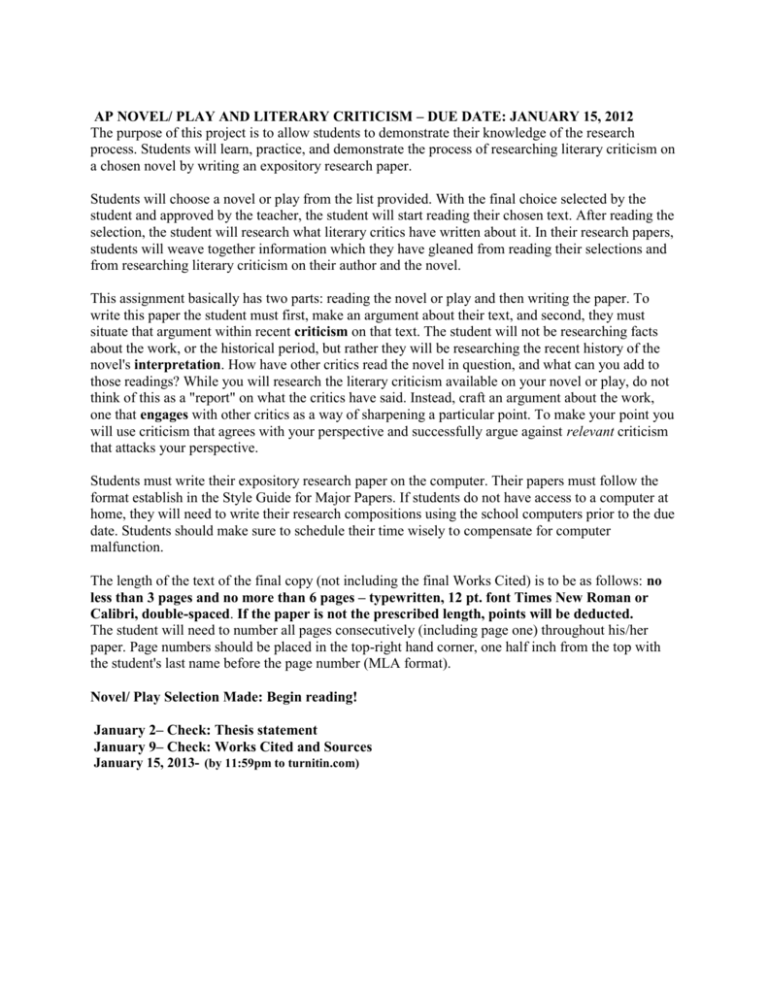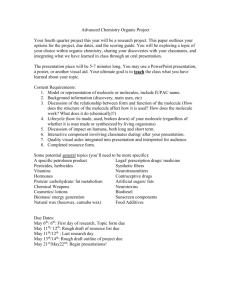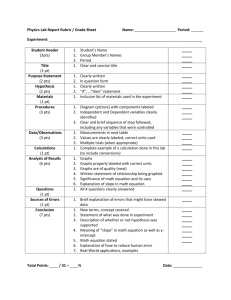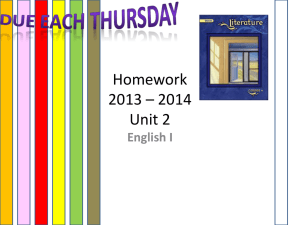AP Research Paper Instructions
advertisement

AP NOVEL/ PLAY AND LITERARY CRITICISM – DUE DATE: JANUARY 15, 2012 The purpose of this project is to allow students to demonstrate their knowledge of the research process. Students will learn, practice, and demonstrate the process of researching literary criticism on a chosen novel by writing an expository research paper. Students will choose a novel or play from the list provided. With the final choice selected by the student and approved by the teacher, the student will start reading their chosen text. After reading the selection, the student will research what literary critics have written about it. In their research papers, students will weave together information which they have gleaned from reading their selections and from researching literary criticism on their author and the novel. This assignment basically has two parts: reading the novel or play and then writing the paper. To write this paper the student must first, make an argument about their text, and second, they must situate that argument within recent criticism on that text. The student will not be researching facts about the work, or the historical period, but rather they will be researching the recent history of the novel's interpretation. How have other critics read the novel in question, and what can you add to those readings? While you will research the literary criticism available on your novel or play, do not think of this as a "report" on what the critics have said. Instead, craft an argument about the work, one that engages with other critics as a way of sharpening a particular point. To make your point you will use criticism that agrees with your perspective and successfully argue against relevant criticism that attacks your perspective. Students must write their expository research paper on the computer. Their papers must follow the format establish in the Style Guide for Major Papers. If students do not have access to a computer at home, they will need to write their research compositions using the school computers prior to the due date. Students should make sure to schedule their time wisely to compensate for computer malfunction. The length of the text of the final copy (not including the final Works Cited) is to be as follows: no less than 3 pages and no more than 6 pages – typewritten, 12 pt. font Times New Roman or Calibri, double-spaced. If the paper is not the prescribed length, points will be deducted. The student will need to number all pages consecutively (including page one) throughout his/her paper. Page numbers should be placed in the top-right hand corner, one half inch from the top with the student's last name before the page number (MLA format). Novel/ Play Selection Made: Begin reading! January 2– Check: Thesis statement January 9– Check: Works Cited and Sources January 15, 2013- (by 11:59pm to turnitin.com) =============================================================== General Steps in the Research Paper Project (See "Specific Explanations of Individual Parts" for more details.) 1. Students will choose and read the selected novel. 2. Students will gather information and literary criticism on their novel from various sources. (Such as the reference Contemporary Literary Criticism - CLC) Students must utilize at least 3 sources. AT LEAST TWO OF THE SOURCES MUST COME FROM ANOTHER SOURCE BESIDES THE INTERNET. 3. Quotation requirement: Students will need to include at least one long quote and one short quote from the novel text AND one quote from each source using the MLA HANDBOOK format. Students will not use more than 10 direct quotes in their papers. No quote can be longer than its subsequent commentary. 4. Students will create a coversheet providing the correct documentation for each source using MLA HANDBOOK format. This cover sheet should be stapled to each source. 5. Students will write note pages / note cards based upon the information in the sources. (optional) 6. Students will type a thesis statement. (all thesis statements were checked) 7. Students will type an informal outline or some method of brainstorming (before writing the research paper). 8. Students will type a rough draft of Works Cited. (optional- only if you want it checked by me) 9. Students will type the rough draft of the research paper including the internal documentation in MLA format as they write. 10. As a part of their rough drafts, students must include the literary criticism they are responding to, and pertinent background research and information found on their novels. 11. Students will develop the introductory paragraph making sure that the thesis statement is the last sentence in the introductory paragraph. 12. Students will develop the concluding paragraph making sure that it concludes or finalizes the paper appropriately. 13. Students should print out the rough drafts of their research paper and the Works Cited. 14. Students can schedule a writing appointment with me, giving me time to read their rough draft prior to the appointment. (if possible I will use some class time for this) 15. Students should take the teacher’s revisions and suggestions to revise their paper, and meet with me for any follow up questions or help before finishing the final draft. 16. Students will type the final copies of their research paper, inputting all necessary revisions. 17. Students will type their final Works Cited. 18. Students will proofread all their final documents and will input changes into their computerized copies. 19. Students will turn in the final copy of their paper to turnitin.com no later than 11:59 pm, January 15, 2013. 21. Students will print out the final copy of their paper. 22. Students will submit their literary criticism research papers by placing all their materials in a large, manila envelope or some type of secure folder. If using a manila envelope please write your first and last names and period number on the manila envelope. 23. They will place all items in the manila envelope in the following order: Under One Paperclip A. Final copy with final Works Cited as the last page B. Some type of basic outline, bullet point schematic, etc. used for prewriting Under a Second Paperclip D. Rough draft of paper E. Rough draft of Works Cited F. Rough outline with thesis statement at the top Under a Third Paperclip- NOT MANDATORY G. Source page with coding Under a Fourth Paperclip – NOT MANDATORY H. Notes Rubber Band Around – NOT MANDATORY I. Note cards (if you used note cards) =============================================================== SPECIFIC EXPLANATIONS OF INDIVIDUAL PARTS – THIS PAPER WILL REPLACE NOTE CARDS IF YOU CHOOSE NOT TO USE THEM Source Packet: cards, preferring that students do all their work on the computer. However, for ease in evaluating students' systematic progress, students will produce a coversheet to be stapled to each source providing the correct documentation using MLA HANDBOOK format. typed or written in INK. - left-hand corner of each source paper. right-hand corner of the source paper which is stapled to each source. As soon as students decide to take notes from a source, they should document the source according to MLA guidelines. also include on each source paper: the type of source (e.g., reference book, database) and the paragraph and page number from which the annotation was taken. Students must use at least 3 sources. AT LEAST TWO OF THE SOURCES MUST COME FROM ANOTHER SOURCE BESIDES THE INTERNET. Note Pages / Note cards: Students should complete at least 25 note entries / cards. Students must do all their notes before they begin to write their rough draft. If notes are taken on paper not note cards, each source should have its own note page(s). Students need to put the source code (alphabetical letter) in the upper-right hand corner of the note paper or card. Students should write their full names in the bottom- left hand corner of the note card or in the top- left hand corner of the note page. They should put the source page number in the bottom-right hand corner of the note card or at the end of that set of notes. Students should either write down word-for-word those statements which sound really interesting and put quote marks on the card to show that they have quoted directly from the source, or they should write the information in their own words – called "paraphrasing." No matter whether a person quotes directly or puts the information in his own words, he must give credit to the source. Students will do this by inserting parenthetical documentation into their papers using MLA format (to be discussed later in this document). Students should write only one main idea per note card / entry and should put the key word on the top- left hand corner of each card, or in the left margin across from the entry. This will make it easy for students to sort their notes by key ideas when they get all their notes finished. When they have finished doing their notes, students should divide them into stacks of similar key ideas. When they have stacked their notes by key ideas, they are ready to write their informal outline. Source page non-internet source: Reference Book [type of source] [assigned letter all notes from B this source will have this letter] Shaw, J. Thomas. “Raskol’nikov’s Dreams.” Slavic and East European Journal. 16, no.1 (Spring 1972): 42-54. Rpt. In Nineteenth-Century Literary Criticism. Ed. Dennis Poupard. Vol. 167. Detroit: Gale, 1988. 399-402. Edyt Dickstein [Student's first and last name] Source page internet source: Online Database [type of source] [assigned letter all notes from A this source will have this letter] Gaydosik, Victoria, “The Blind Assassin” Facts On File Companion to the British Novel: 20th Centrury, vol. 2. Bloom’s Literary Reference Online. Facts On File, Inc. Web. 15 Sept. 2009 Edyt Dickstein [Student's first and last name] Format Reference: Book: Author’s Last name, First name. "Title of Essay." Title of Collection. Ed. Editor's Name(s). Place of Publication: Publisher, Year. Page range of entry. Medium of Publication. Database: Editor, screen name, author, or compiler name (if available). “Posting Title.” Name of Site. Version number (if available). Name of institution/organization affiliated with the site (sponsor or publisher). Medium of publication. Date of access. Your note pages should look like this: Edyt Dickstein [Student's first and last name] [Source code] A Symbolism [Key word] When the red pickle dish, a gift from Zeena’s Aunt Philura Maple, shatters it symbolizes the broken nature of the Frome’s marriage, which Ethan is unable to glue back together. [Information either paraphrased (in student's own words) or quoted (quote marks)] [P. # in source] p. 37 Your note cards should look like this: Symbolism [Key word] [Source code] A When the red pickle dish, a gift from Zeena’s Aunt Philura Maple, shatters it symbolizes the broken nature of the Frome’s marriage, which Ethan is unable to glue back together. [Information either paraphrased (in student's own words) or quoted (quote marks)] Edyt Dickstein [Student's first and last name] [P. # in source] p. 37 Rule of thumb: It is better to have too many sources and too many notes than not enough to cover the subject matter adequately. Rough Outline and Thesis Statement Students should type the words "Rough Draft Outline" at the top of a page. After looking at the key ideas on their notes, they should come up with one overarching idea for their paper. This is called a thesis statement (a single sentence – a concise idea the writer will try to expand on in his composition). Students should write the thesis statement at the top of the rough draft outline. Students will use a COMPLETE SENTENCE type of outline. They will need to double-space their outline. Each body paragraph in the student's paper must have a topic sentence; therefore, each student should make each Roman numeral a topic sentence which indicates each body paragraph. The support ideas that explain the topic sentence will be listed in descending order. Here is an example to follow: THESIS STATEMENT I. Topic sentence of first body paragraph A. First support idea 1. First sub-idea 2. Second sub- idea B. Second support idea 1. First sub-idea 2. Second sub- idea Students should feel free to make changes in ink on their rough draft outline as they compose their rough draft composition. Remember the more complete your outline is the more helpful feedback I can give you. Rough Works Cited Students should type their rough Works Cited by alphabetizing their sources and following the MLA HANDBOOK format. Rough Draft Using their rough outline as a guide, students should begin to write their rough draft of the research paper. They need to double-space their papers. Each time that the student uses a direct quote or an idea from a source, credit must be given by inserting parenthetical documentation. Rule of thumb: When in doubt, cite the source! As the student writes his paper, he will need to insert parenthetical documentation at the end of each new source or at the end of each paragraph if the same source is used continuously for a number of paragraphs. Into the content of their papers, students will weave background information, material from the novel they have chosen to read, and literary criticism from experts. When the student finishes writing her body paragraphs, she should go back and write the introductory paragraph and the concluding paragraph. She should be sure to put her thesis statement as the last sentence in her introductory paragraph. Both the introductory and concluding paragraphs should be of similar length. At this point, the student may print out his rough draft. He must then go back and insert IN INK all the spelling/grammar/capitalization/usage corrections, revisions, and strong adjectives and verbs. A color coded Ratiocination sheet may also be used. This step must not be skipped! It is easy to miss errors when they are on the computer screen. After the final corrections are made print out the rough draft you will turn in for review. Students should also go back and check the end of each paragraph to see if the beginning of the next paragraph has some key words which connect it to the previous paragraph. Students should insert transitional words between sentences inside the paragraphs in order to make the ideas connect to each other. Final Copy of Research Paper Students will need to follow MLA format for paper (organization, parenthetical citation, pagination, works cited, etc.). Students should be sure the length of their paper is 3 to 5 pages. They should be sure their printer produces a dark, legible copy. Students should keep a photocopy or a disk copy of their finished papers until the final grades are recorded. Students MUST work well ahead of all deadlines because computer problems may arise. Final Works Cited Students should follow MLA format. The final double-spaced Works Cited should be affixed to the back of the final copy. Students should be sure they list only the sources they utilized in their paper. The entries are to be alphabetized by the first word in the annotation, and each entry must be written with a hanging indent. Final Outline The title of the research paper should go on the first line of the outline. The final outline may well look very different from the rough draft outline since changes frequently occur as the paper is being generated. Source Packet Each source must be stapled to a separate coversheet with the bibliographic information written at the top of the coversheet in MLA format. Students must Xerox all pages from which they took information that they utilized in their final copies. (Suggestion: Students may wish to make two copies of their source information -- one to mark up while they are preparing their paper and the other to highlight for the final source packet.) Students must be sure to put the alphabetical letter code in the top-right hand corner of both the coversheet and the Xeroxed source material. They should not highlight until after they have finished writing their final papers. Students should highlight in PINK (or another color besides yellow) on the Xeroxed source material all the words which they copied word- for-word (directly quoted) in their final copy. They should highlight in YELLOW on the Xeroxed source material all the information which they paraphrased (put in student's own words) in their final copy. Here are two rules of thumb to follow in order for a person to avoid plagiarism: (1) When a student writes four or more words in a summary/paraphrase which appear the same as they are written in the source, he needs to give credit to the source (parenthetical documentation). (2) When in doubt, a student should cite the source. DUE DATES: All work is due at the beginning of class on the dates listed, except those marked due at end of class. No excuses, including computer problems, will be accepted. Students should plan ahead and have their work ready well ahead of the due dates. If you are having a problem with any part of the assignment, talk to me before a due date, not after. If the student is absent at the time an assignment is due, he must send his work to the teacher by the beginning of English class the day student is back in school. No final copies of papers will be accepted without the accompanying rough draft outline/thesis statement, rough draft of paper with revisions marked, rough draft of Works Cited, final outline, final paper, and final Works Cited. Submission to turnitin.com is only one step; it is not sufficient by itself. Also note: Many of these novels and plays have had excellent movie adaptations made of them. Feel free to watch them and use them as a source for your research. However, remember viewing them cannot take the place of reading the novel or play. ALL WORK DUE: Tuesday, January 15 GRADING: The process grade and the research paper grades will be recorded separately. Students will receive grades based upon the following rubrics: PROCESS GRADE- TOTAL POINTS ON _______ / 100 Pts (TEST GRADE) Use of all sources -- 20 pts. ______ Pts. Use of literary criticism – 20 pts. ______ Pts. Use of Direct quotations -- 20 pts. ______ Pts. Length -- 8 pts. ______ Pts. Appearance/Form: first page format -- 4 pts. ______ Pts. pagination -- 4 pts. ______ Pts. margins -- 4 pts. ______ Pts. Works Cited -- 20 pts. ______ Pts. RESEARCH PAPER FINAL GRADE– 150 Points Total (TWO TEST GRADES) Outline (quality of information) -- 20 pts. ______ Pts. Thesis statement -- 10 pts. ______ Pts. Grammar and mechanics -- 20 pts. ______ Pts. Writing and organization of ideas- 50 pts. Source Quality- 10pts. Format Followed- 10 pts. MLA Format of Notes and Sources -- 30 pts. ______ Pts. MLA Citation for Literary Criticism Parenthetical example (in the text of your paper): For the heroine, the world is defined in terms of love and marriage, and "the art of living" comes with a realization that such art is difficult or impossible; the price for the art is often tragic endings. Rosowski calls this female awakening "an awakening to limitations" (Bloom 43). Works Cited examples (in your Works Cited list): Bloom, Harold, ed. Kate Chopin. Modern Critical Views. New York: Chelsea House Publishers, 1987. Example of secondary Sources Originally Published for a Specific Source Forman, Robert J. “Emily Dickinson.” Magill’s Survey of American Literature. Vol 2. Ed. Frank N. Magill. New York: Marshall Cavendish Corporation, 1991. 509-527. Johnson, Jeannine. "The Bell Jar: Criticism." Novels for Students. Vol 1. Ed. Diane Telgen. Detroit: Gale Research, 2000. 34-35. Example of secondary sources Reprinted from Other Sources such as Gale series like Contemporary Literary Criticism, Twentieth Century Literary Criticism Pallen, Charles. “Mark Twain.” Criticisms on Twain. (1984): 23-32. Rpt. In Twentieth-Century Literary Criticism. Ed. Dennis Poupard. Vol. 25. Detroit: Gale, 1988. 399-402. Cochran, Robert W. “Circularity in The Sun Also Rises.” Vol XIV. (1968): 297-305. Rpt. In Novels for Students. Eds. Sheryl Ciccarelli and Marie Rose Napierkowski. Vol 5. Detroit: Gale, 1999. 342-347. Example of an Internet Citation Gaydosik, Victoria. "The Blind Assassin." Facts On File Companion to the British Novel: 20th Century, vol. 2. Bloom's Literary Reference Online. Facts On File, Inc. Web. 15 Sept. 2009. Langhamer, Claire. “Love and Courtship in Mid-Twentieth-Century England.” Historical Journal 50.1 (2007): 173-96. ProQuest. Web. 27 May 2009.







